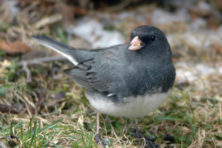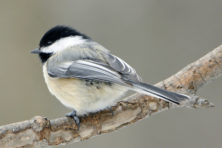Results from Sturgeon Bay and Brussels Christmas Bird Counts
- Share
- Tweet
- Pin
- Share

Record-highs for bald eagles in Sturgeon Bay and tundra swans in Brussels
The annual winter bird surveys that we do on a single day during the specific three-week window, Dec. 14 to Jan. 5, are so different from one year to the next. The weather, of course, plays an important role, but so does the amount of snow cover – or lack thereof.
This year there was no snow and the warmer-than-usual weather meant mostly open water with very few icy shorelines. We had 20 households watching and counting at their bird feeders in the Sturgeon Bay circle and eight for the Brussels count.
The lack of snow meant that birds could find lots of natural food, like weed seeds and insect eggs, and did not have to come to feeders for their meals. This condition makes for unhappy feeder watchers at homes throughout both counts. It also can make it difficult to find the birds in the open landscape; they tend to blend in with their surroundings.
Red-tailed and rough-legged hawks are the large, open-country raptors that seek small rodents in the fields. They had good hunting conditions as did the northern harriers. These species were seen during both bird counts.
Northern harriers tend to fly low, just a few feet above the ground, as they look for mice or meadow voles over open fields. Their white rump patch is a good field mark. That feature is also seen on rough-legged hawks. However, those birds fly at a much higher elevation and can hover in one place like the American kestrels.
Other species seen in the open countryside are ring-necked pheasants, which are not native to this country. They are raised and released for local hunters. Ruffed grouse are seen near woodlands and their numbers have been quite low for the past few years. Twenty were seen on the 1998 Sturgeon Bay count and only one was reported this year. Only three were seen on the Brussels count this year.
Bald eagles were very rarely seen when we began the counts in 1996. This year, 17 were counted in the Sturgeon Bay circle and 23 in the Brussels area. In fact, the 17 for Sturgeon Bay was a new record high. Last year, Brussels set a record high with 60 eagles seen during that count.
Tundra swans used to be just migratory, spending the winter in the Chesapeake Bay area south of Baltimore. Now some can be seen here all winter as long as the lake remains open. The Sturgeon Bay count had no swans for 15 years. This year, 164 were seen and the high number was in 2012 with 257. The Brussels circle went 11 years with no tundras and set a record high of 183 this year.
Several observers told me that the mallard numbers were lower than usual. Sturgeon Bay had a record high of 1,388 in 2005. This year, only 391 were counted. The Brussels circle high number was 1,043 in 1999. This year only 156 were seen.
Herring gulls are the larger of the two common resident gulls here in summer. They usually don’t migrate like the smaller ring-billed gulls. The record high of herring gulls was 686 in 2001; this year the Sturgeon Bay circle had only 248.
Many people see mourning doves at the feeders or along power lines in the countryside. Their numbers are also much lower than the record high in Sturgeon Bay (727 in 2007), with only 196 counted this year. The Brussels record high was 325 in 2017, but only 83 were seen this year.
If you have flowering crab trees on your property you may have noticed they were heavy with fruit. This may be why the cedar waxwings were in great abundance on our counts. The Sturgeon Bay circle had 254; the record high was 447 in 2011. Brussels had 116 – not far from the record 119 set in 2003.
Two species we hoped to see were snow buntings and common redpolls. None were seen on either count. The Sturgeon Bay record for snow buntings was 429 in 2005 and for Brussels it was 573, also in 2005. Common redpoll high numbers for Sturgeon Bay were 228 in 1999 and for Brussels, 588 in 1997.
Who knows how much the Canadian wildfires may have affected these birds that nest up there. The breeding population can fluctuate from year to year, but the destruction of so much habitat may have a much longer-lasting change to the plants and food supply that the nesting birds need.
These annual Christmas bird counts will help scientists and environmental managers understand what is happening to our continent’s avian population. Global climate change might have more effect than we realize.



